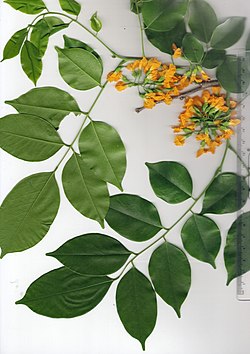| Burma padauk | |
|---|---|
 | |
| Scientific classification | |
| Kingdom: | Plantae |
| Clade: | Tracheophytes |
| Clade: | Angiosperms |
| Clade: | Eudicots |
| Clade: | Rosids |
| Order: | Fabales |
| Family: | Fabaceae |
| Subfamily: | Faboideae |
| Genus: | Pterocarpus |
| Species: | P. macrocarpus |
| Binomial name | |
| Pterocarpus macrocarpus | |
| Synonyms [3] [2] | |
List
| |
Pterocarpus macrocarpus, or Burma padauk, [4] is a species of tree in the family Fabaceae . [3] [5] It is native to the seasonal tropical forests of southeastern Asia: in Myanmar, Laos, Cambodia, Thailand, and Vietnam. [2] [6] [7] It has been naturalized in India and the Caribbean. [6]



